CHECKLIST OF BOSTON RETAILERS IN ARTIST'S MATERIALS: 1823–1887
Norman E. Muller
ABSTRACT—The idea of stenciling canvases with the trademark of the shop selling artist's materials originated in London in the late 1790's. By the 1830's, New York City adopted the English idea; a decade later other large American cities followed suit, such as Philadelphia and Boston. Stencils can often be used as a means of dating paintings when they do not contain any other identifying marks, as frequently the stencil bears the address of the preparator. These individuals, perhaps due to the vagaries of the business, frequently moved, so that one is assured in these instances that the fabric was prepared within a short span of time. The business directories of large cities are a convenient source of information on these art supply retailers. By carefully recording all of these individuals and the dates when they were at a specific location, as has been done for Boston, one can fix the dates of stencils that are discovered. Other data, such as the positioning of the stencil and the color of ink used, are important criteria which may reflect the idiosyncracies of the preparator. This information, in quantity, may be of use in dating unaddressed stencils.
1 INTRODUCTION
In 1973 an article by this author, titled “Boston Canvas Stencils, Origin and Interpretation,” appeared in the Premier Issue of the American Art Review.2 That article did not include a list of the Retailers, and it is therefore being published here along with photographs of their stencils.
The idea for stenciling canvases seemingly originated in London in the 1790's when Thomas Brown, Thomas Poole, and Reeves and Sons opened shops.3 Canvases bearing their stamps were shipped to the United States and have occasionally been found on American paintings, one of the earliest being a Poole stencil on a painting by John Brewster (1766–1846).4 It was not until the 1830's, however, that the idea of stenciling canvases took root in the United States, principally in New York City.5 Thereafter, the idea spread, and by the 1840's most of the major eastern cities, such as Boston, had shops issuing these unique trademarks.
It will sometimes be observed that the stencils read “From” a particular retailer. This often means that the fabric was prepared by someone else and simply sold by a second party, who often impressed his own stencil. For example, canvases sold by J. J. Adams often bear two stencils: his own, which is headed by “From” as shown in Figure 1a, and the preparator, which in one instance was G. Rowney of London, shown in Figure 1b. In the latter case, the Rowney stencil was partially hidden by the stretcher member, which suggests that the prepared linen was probably shipped to Adams on a roll with the Rowney stencils imprinted at regular intervals. Cutting the roll to irregular sizes could account for the partial obscuring of the Rowney stencil. Similarly, the stencils of N. D. Cotton, shown in Figure 3, clearly state that the linen was prepared in England. As no English stencil was found on the one example discovered by the author, perhaps—and I emphasize this word—the roll of linen never bore stencils of the English preparator.
Fig. 1a.
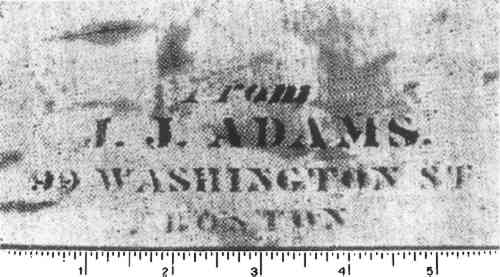 |
Fig. 1b.
Stencil size: 4.1 cm (1–5/8″); Color of Ink: Black; Occurrences: 1. Anon, John Whipple of Beverly off Minot's Light, dated 1851, P.M. Stencil located in corner. 2. Anon, Barth Children, dated 1851. Private collection. 3. Anon, Ship off Minot's Light. Private collection. Pre-primed. Stencil from G. Rowney, 51 Rathbone Place, London, was also noted on the same fabric (Fig. 1b), partially obscured by the stretcher member. Rowney was at this address from 1815–1858. 4. Anon, Samuel Baker Walcott (1795–1854), E.I. Fabric pre-primed. G. Rowney, 51 Rathbone Place, London, stencil was also noted. 5. C. Drew, Ship Witch of the Wave, built 1851. P.M. Also stencil of G. Rowney, 51 Rathbone Place, London. 6. Chester Harding, Portrait of a Woman. M.F.A. Stencil centered.
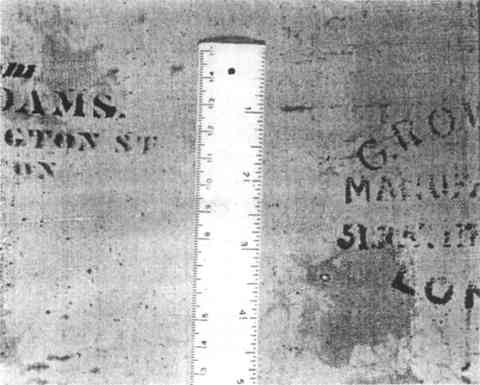 |
Fig. 3.
Stencil Size: 7.0 cm (2–3/4″); Color of Ink: Black; Occurrences: Alvan Clark, Charles H. Cummings, M.F.A. Stencil centered. A Cotton stencil for the 272 Washington St. address was found on Sanford Gifford's Intervale Valley, New Hampshire, Phoenix Art Museum, Phoenix, Arizona.
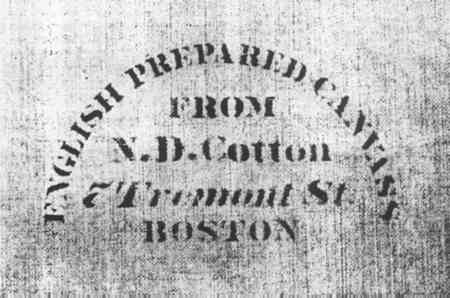 |
Figure 2 shows a double stenciled canvas from Boston. On the left side was the stencil of J. J. Adams and to the right, alongside it, was the stencil of O. Stearns, which read “Prepared by.” Obviously, Stearns prepared the canvas and Adams sold the product. Since the painting presumably bore the date 1846, Adams' stencil would be the first impression he used at 99 Washington Street. Unlike the other stencils Adams used which have the “From” slanted, as shown in Figure 1a, the early example has the letters upright. Stearns' stencil probably dates from his location at 91 Washington Street, only a few doors away from Adams' shop.
Fig. 2.
Occurrences: Combination Adams and O. Stearns stencil on a painting by Thomas H. Hinckley, ca. 1846. Sizes unknown. Courtesy of Carroll Wales, Boston.
 |
The Morris stencils are varied and extremely interesting, as shown in Figures 8 to 12. With the discovery of a new C. A. Morris stencil on a painting in California, as shown in Figure 11, and the identification of the subject,6 the date for this stencil and one previously misinterpreted, as shown in Figure 10, now seems resolved.
Fig. 8.
Stencil Size: 9.7 cm (3–13/16″); Color of Ink: Black; Occurrences: 1. Charles Osgood, William Henry Honeycomb, E.I. Stencil located in corner. 2. Anon, Mrs. Sarah G. Honeycomb, E.I. Stencil in corner. 3. Clement Drew, Unidentified Ship, P.M. 4. C. Drew, Brig Cecelia, P.M. 5. C. Drew, H. H. Cole (built 1843), P.M. 6. R. Salmon (attrib.), U.S. Revenue Cutter Hamilton, P.M. 7. Anon, Ann M. Goodridge, E.I.
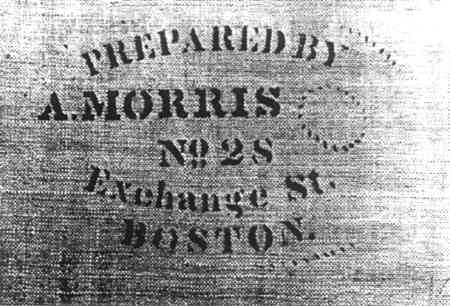 |
Fig. 9.
Stencil Size: 5.0 cm (2″); Color of Ink: Black; Occurrences: C. Drew, Ship Sophia, dated 1846, P.M.
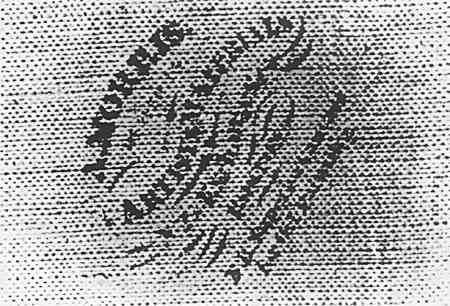 |
Fig. 10.
Stencil Size: 7.0 cm (2–3/4″); Color of Ink: Black; Occurrences: C. Drew, Steamship Seagull (built 1848), P.M. Stencil angled in corner.
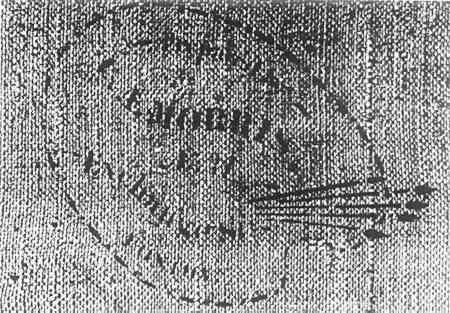 |
Fig. 11.
Stencil Size: 9.7 cm (3–13/16″); Color of Ink: Black; Occurrences: Anon, Arnold Cook Janes, Claremont Colleges Gallery, Pomona, California. Stencil in corner.
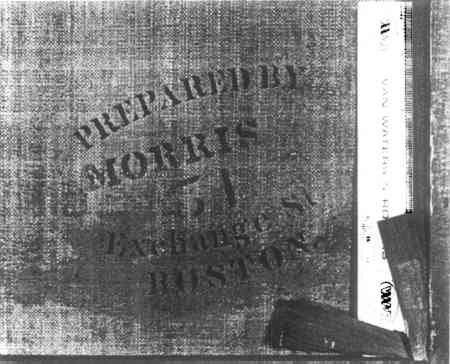 |
Fig. 12.
Stencil Size: 9.7 cm (3–13/16″); Color of Ink: Black; Occurrences: C. Drew, Bark Ionia (built 1847), P.M.
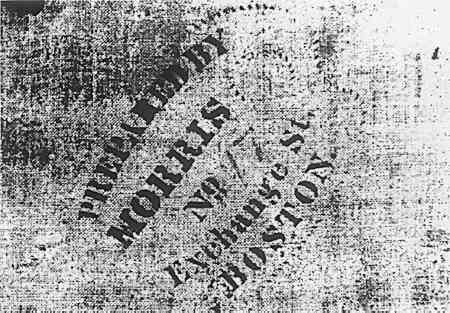 |
It should be observed that reference is often made in the checklist to the positioning of the stencil, color of ink used, and whether the fabric was primed by the preparator. This information, while sketchy now, may have greater significance when other paintings are examined and compared with the data contained herein. It is my feeling that the job of preparing the canvas may often have been delegated to an assistant, and that this individual's feeling for design may be reflected in the position of the stencil in relationship to the stretcher border. Moreover, certain colored inks may have been used in certain years. Most inks were black, but in one instance M. J. Whipple used blue.
In the checklist, the sizes correspond to greatest height. A few abbreviations have also been incorporated. E. I. stands for the Essex Institute, Salem, Mass; M. F. A. for the Museum of Fine Arts, Boston; and P.M. for Peabody Museum, Salem, Mass.
2 CHECKLIST
- J. (JOHN) J. ADAMS1835–1838 15 Exchange St.1839 7 Water St.1840–1845 72 Washington St.1846–1857 99 Washington St. (Figs. 1a, 1b, 2)Adams originally retailed brushes (1835–1842), and later specialized in artist's supplies (1843–1857). His business was bought by Charles and William M. Vaughan in 1858 and they ceased to carry artist's materials.
- T. (THOMAS) A. ARMS1857; 1860–1861; 1866 270 Washington St.Arms was listed as a gilder and framemaker at this address in 1858.
- A. BEISSBARTH1879 30 Bennington1880 80 MeridianBrush manufacturer.
- BRAINARD, BAKER & BURGESS1871 22 Broad St.Artist's supplies.
- C. T. CLARK1854–1855 61 HanoverArtist's supplies.
- N. D. (DAVIES) COTTON1844–1852 13 Tremont Row1853–1856 7 Tremont Row (Fig. 3)1857–1858 272 Washington St.Stationer, 1844–1852; Artist's supplies, 1853–1858. From 1837–1839 Cotton was in partnership with Mr. Barnard at 184 Washington St., selling books and stationery. The following year Cotton and J. S. Levely operated a stationery and art supply shop at 13 Tremont St.
- CROWELL BROS. & CO.1869–1870 92 Sudbury St.Artist's supplies.
- S. (STEPHEN) A. DIX1821 1 Union St.1822–1823 48 State St.1827–1831 112 State St.Paint dealer.
- G. H. DREW1855–1856 270 Washington St.1858–1859 18 CourtArtist's supplies. In 1857 Drew was a print dealer at 18 Court.
- CHARLES J. EDMANDS1883 4 Bromfield St.1884–1894 12 Bromfield St. (Fig. 4)4
Occurrences: 1. C. Drew, Bark Soudding, dated 1887. Fabric pre-primed. P.M. 2. C. Drew, Eastern Point Light, dated 1888. Fabric pre-primed. P.M.Artist's supplies
- G. F. EMMONS1884–1885 767 Washington St.Artist's supplies.
- FROST & ADAMS1869–1880 33 and 35 Cornhill (Figs. 5 and 6)1881–1919 37 Cornhill5
Stencil Size: 12.9 cm (5–1/16″); Color of Ink: Black; Occurrences: 1. Anon, Landscape. Private collection. Stencil centered. 2. T. H. Hinckley, signed 1878. Vose Gallery, Boston.6
Occurrences: 1. C. Drew, Boon Island Lighthouse, dated 1872. P.M. 2. F. Shaw, dated 1876. Vose Gallery, Boston.Artist's supplies. Frost & Adams acquired the business of M. J. Whipple in 1869 and operated from the same location.
- GARDNER & CHANDLER1882 1321 Washington St.Artist's supplies.
- HENRY H. GREEN1880–1882 938 Washington St.Artist's supplies.
- MRS. F. C. GRIFFITH1886 144A Tremont St.1887 25 Winter St.Artist's supplies.
- F. C. HASTINGS1869–1886 54 Cornhill. Business at same address from 1887.Artist's supplies.
- A. K. M. HEATH1886 2387 Washington St.Artist's supplies.
- LAMBERT HOLLIS1869 46 Temple PlaceArtist's supplies.(CHARLES) HOLLIS & CO. (WHEELER)1842–1849 59 Union St. (Fig. 7)7
Stencil Size: 13.1 cm (5–1/8″); Color of Ink: Black; Occurrences: 1. J. Harvey Young, Eliza Maria and Lucretia Hawes Symonds, dated 1847, E.I. Fabric pre-primed. Stencil located in corner on angle. 2. Anon, Washington L. Deland, E.I. Fabric pre-primed. Stencil in corner on angle. 3. E. H. Rogers, John Rogers, dated 1847, E.I. Stencil in corner on angle. 4. Wm Marsh, Brig Mary Pauline, dated 1843, P.M.Artist's supplies. The firm was called “Hollis & Wheeler” from 1843–1849.
- FREDERIC G. KIMBALL1881 82 Water St.Artist's supplies.
- A. (APOLLOS) MORRIS1835–1836 112 State St.1838–1842 Same address1843 11 Union St.1844–1848 28 Exchange St. (Figs. 8 and 9)Artist's supplies. Morris in partnership with Dix at 112 State St. from 1833–1834; and with W. G. Ladd at the same address in 1837.
- C. (CHARLES) A. MORRIS1847–1848 28 Exchange St. (Read 31 Exchange St.?) (Figs. 10 and 11).1849 17 Exchange St. (Fig. 12)1850–1851 51 SuffolkArtist's supplies.
- F. W. PERKINS1881–1882 1695 Washington St.Artist's supplies.
- FRANK J. POPE1887–127 Tremont St.Artist's supplies.
- JOHN POPE1856 6 Winter St.1857 16 Summer St.Artist's supplies.
- E. E. REED1885 200 SouthArtist's supplies.
- JAMES SCALES1884 44 Bromfield St.Artist's supplies.
- S. SEVERY1885–1886 534 Tremont St.Artist's supplies.
- EBEN SMITH1883–1884 182 LincolnArtist's supplies.
- L. R. SPRINGER1868–1874 351 Washington St.Artist's supplies.
- O. (OLIVER) STEARNS1842 5-1/2 Tremont Row (Fig. 13)1843–1844 7 W. Centre1845 27 School St.1846 91 Washington St. (See Fig. 2)1848 26 Bromfield St.1849–1850 9 Amory Hall (Fig. 16)13
Occurrences: Anon, Portrait of Captain Timothy Lewis, location unknown. Stencil centered.16
Occurrences: Data unknown. Photograph courtesy Carroll Wales, Boston.14
Stencil Size: 8.9 cm (3–1/2″); Color of Ink: Red; Occurrences: Clement Drew, Unidentified Ship, P.M.15
Stencil Size: 8.1 cm (3–13/16″); Color of Ink: Black; Occurrences; 1. Francis Alexander, Zachary Taylor, dated 1848, E.I. Stencil placed in corner. 2. Clement Drew, Brig Vintage (built 1837), P.M. Stencil placed in corner. Originally this stencil thought to be different because of its slightly smaller size (8.5 cm (3–5/16″)), but seems to be simply a poor impression of Fig. 15.Artist's supplies.
- S. VINTON STILLINGS1883–1884 54 Bromfield St.Artist's supplies.
- CHARLES STIMPSON JR.1823 80 State St.1829 72 Washington St.Stationer. Also retailed watercolors and brushes.
- STIMPSON (CHARLES) & CLAPP1832 72 Washington St.Stationers and Booksellers.
- STIMPSON (CHARLES) & HUNT1827–1828 8 Court St.Booksellers
- WILLIAM C. STIMPSON1829–1831 3–4 Fanueil HallDrugs and Paints.
- T. (TILLY) & T. B. BRIGHAM1834 8 Ann St.Paint Retailer.
- J. E. TILTON & CO.1860 161 Washington St.Artist's supplies and Booksellers.
- M. B. TOBEY1869 28 Temple PlaceArtist's supplies.
- UNION MFG. CO.1885–1886 72 Franklin St.Artist's supplies.
- WADS WORTH BROS. & HOWLAND1877–1880 76 Washington St.1881 46 Friend St.1882–1893 84 Washington & 46 Friend (Fig. 18).
- A. A. WALKER1867–1870 322 Washington St.1871–1876 127 Tremont1877–1880 594 Washington St.1881– 538 Washington St.18
Stencil Size: 4.0 cm (1–9/16″); Color of Ink: Black; Occurrences: A. Chapman, Seascape, dated 1893, Private collection. Stencil centered.17
Stencil Size: 4.3 cm (1–11/16″); Color of Ink: Black; Occurrences: 1. Stubbs, Ship Zingara (built 1856), fabric pre-primed. P.M. 2. Stubbs, Unknown Subject, Vose Gallery, Boston.Artist's supplies.
- WATERMAN & CO.1877 535 Washington St.1878 533 & 535 Washington St.1879 535 Washington St.Artist's supplies.
- A. (ASAHEL) WHEELER1850–1851 59 Union St.1852–1858 73 Union St. (same address as above; renumbered in 1852)1859–1860 61 & 63 Union St.1862–1863 41 Water St.1864–1872 67 Water St.1877 141 Milk St.1878–1880 145 Milk St.1884– 145 Milk St.Artist's supplies.
- M. J. WHIPPLE1846 7 Water St.1848–1868 35 Cornhill (Fig. 19)19
Stencil Size: 9.3 cm (3–11/16″); Color of Ink: Blue (see occurrence #1); black otherwise. Occurrences: 1. J. W. A. Scott, Landscape, dated 1862, private collection. 2. C. Harding, Mrs. Mary Dugan, dated 1848. Fabric pre-primed. E.I. 3. C. Harding, James Bayley, undated. Fabric pre-primed. Stencil located in corner. E.I. 4. Charles Osgood, Mrs. Abigail Devraux Waters, dated 1853. Fabric pre-primed. E.I. 5. Charles Osgood, Thomas Cole, undated. Fabric pre-primed. Stencil located in corner. E.I. 6. Thomas H. Hinckley, Rotherham, Yorkshire, England, M.F.A.Stationer and bookseller, 1846–1849; artist's supplies, 1850–1868.
- J. C. WHITE1886 10 Bromfield St.Artist's supplies.
- J. W. WIGGIN1881–1884 11 ChardinArtist's supplies.
- J. A. WRIGHT1880 535 Washington St.Artist's supplies.
- HERMAN F. ZAHM1859 270 Washington St.1860 284 Washington St.Stationer and artist's supplies.
ACKNOWLEDGEMENTS
The author wishes to express his gratitude to the staff of the Essex Institute and the Peabody Museum of Salem, and to the numerous individuals who helped him in preparing the original manuscript and responded to the article once it was in print.
REFERENCES
Conservator, Worcester Art Museum, 55 Salisbury Street, Worcester, Mass. 01608.
September-October1973, Vol. 1, No. 1, pp. 108–114.
This information was derived from Cathy Leach's, A Reference List of Firms Preparing Artist's Canvas in 19th Century London, a mimeographed copy she had prepared several years ago. Miss Leach has since moved to the United States, where she is a conservator at the North Carolina Museum of Art. Since leaving England, a colleague of hers, Alec Cobbe of the Conservation Department, City Museums, Birmingham, has been collecting stencils and soon plans to publish a book of illustrations. Thomas Brown, by the way, patented collapsible color tubes. Small notices to this effect appeared in the London The Art-Union in 1841.
Caroline K.Keck, A Handbook on the Care of Paintings, American Association for State and Local History, 1965, pp. 47–48.
See RalphMayer's, “Some Notes on Nineteenth Century Canvas Makers,” Technical Studies in the Field of the Fine Arts, X, (1941), pp. 131–137.
In 1974 a Morris stencil, as shown in Figure 11, was found on the back of a portrait of a young child of about two, named Arnold Cook Janes, located in the collection of the Claremont Colleges in Pomona, California. The size and format of the stencil corresponded exactly to similar stencils by Apollos and Charles A. Morris, as shown in Figures 8 & 12. A check of the genealogical records of the Janes family revealed that there were two Arnold Cook Janes, one born in Charlestown, Massachusetts on November 16, 1841, who died at the age of two, and a second child born on August 23, 1845, who died on September 16, 1847. Since neither of the Morrises is known to have had a shop on Exchange Street in 1843 (the year the first Arnold died), the second child is probably the one shown in the painting. Apollos Morris was at 28 Exchange Street from 1844–48 with no interruptions. Charles is shown in the business directories to have been at this same address from 1847–48; no stencils of Charles bearing this street number have ever been located. The compilers of the directory could easily have mistaken Charles for Apollos and listed him at 28 Exchange Street rather than at 31 Exchange. Consequently, the author proposes the date of 1847–48 for Figure 11 and for Figure 10, which was incorrectly interpreted as 28 Exchange Street in the American Art Review article.
 Section Index Section Index |
 Section Index
Section Index







